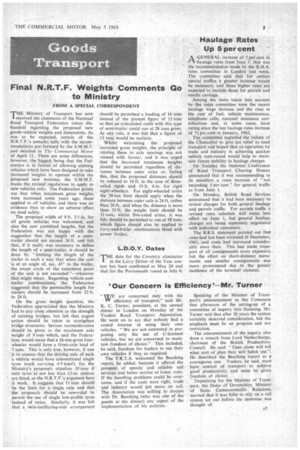Final N.R.T.F. Weights Comments Go • to Ministry
Page 7

If you've noticed an error in this article please click here to report it so we can fix it.
FROM A SPECIAL CORRESPONDENT
"THE Ministry of Transport has now J. received the comments of the National Road Transport Federation (since disbanded) regarding the proposed new goods-vehicle weights and dimensions. As was to be expected, certain of the N.R.T.F.'s remarks tally with the recomnaendations put forward by the S.M.M.T. and detailed in Th:, Commercial Motor of April 12. There are some differences. however, the biggest being that the Federation is in favour of allowing existing vehicles which have been designed to take increased weights to operate within the proposed new maxima; the S.M.M.T. wants the revised regulations to apply to new vehicles only. The Federation points out that when maximum gross weights were increased some years ago, these applied to all vehicles, and there was no evidence then to show an adverse effect on road safety.
The proposed width of 8 ft. 2.5 in. for all goods vehicles was welcomed, and also the new permitted lengths, but the Federation was not happy with the suggestion that the length of a semitrailer should not exceed 36 ft. and felt that, if it really was necessary to define the length of a semi-trailer, it should be done by "limiting the length of the trailer in such a way that when the unit is at an angle of, say, 45° to the trailer, the swept circle of the outermost point of the unit is not exceeded "—whatever that might mean. Regarding vehicle-andtrailer combinations, the Federation suggested that the permissible length for trailers should be increased from 22 ft. to 28 ft
On the gross weight question. the Federation appreciated that the Ministry had to pay close attention to the strength of existing bridges. but felt that urgent action should be taken to strengthen bridge structures. Serious reconsideration should be given to the maximum axle weight of 9 tons which, said the Federation, would mean that a 16-ton-gross fourwheeler would have a trent-axle load of 7 tons. This is only true, however, if one is to assume that the driving axle of such a vehicle would have conventional single tyres (each carrying 4-5 tons!). for the Ministry's proposals stipulate 10 tons if twin tyres at not less than 12-in, centres are fitted, so the N.R.T.F.'s argument here is weak. It suggests that II tons should be the limit for a single axle and that the proposals should be reworded to permit the use of single low-profile tyres 'instead of twins. Similarly, it was felt that a twin-oscillating-axle arrangement
should be permitted a loading of 14 tons instead of the present figure of 11 tons so that an articulated outfit with this type of semi-trailer could run at 28 tons gross. At any rate, it was felt that a figure of 13 tons would be realistic.
Whilst welcoming the proposed increased gross weights, the principle of relating these to axle spacings was not viewed with favour, and it was urged that the increased maximum weights should be permitted regardless of distances between outer axles or, failing this, that the proposed distances should he reduced to 16 ft. in the case of threeairled rigids and 19 ft. 6 in. for rigid eight-wheelers. For eight-wheeled art ics the 28-ton limit should apply when the distance between outer axle is 24 ft. rather than 26 ft., and when the distance is more than 35 ft. the weight limit should be 32 tons, whilst five-axled artics, it was felt, should be permitted to run at 38 tons, which figure should also be applied to lorry-and-trailer. combinations fitted with power brakes, L.D.O.Y. Dates THE date for the Coventry eliminator in the Lorry Driver of the Year contest has been confirmed as May 26 and that for the Portsmouth round as July. 6.




















































































































































































































































